Hiroshi Abe,
Yoshie Matsuo1 and Ken-ichi Ohshima2
Department of Materials Science and Engineering,
National Defense Academy, Yokosuka 239-8686, Japan
1Department of Physics, Faculty
of Science, Nara Women's University, Nara 630-8263, Japan
2Institute of Applied Physics, University
of Tsukuba, Tsukuba 305-8573, Japan
J. Phys. Soc. Jpn. 68, pp. 2648-2653 (1999).
The effect of atomic vacancies relating to martensitic phase
transition in an Au-47.5at.%Cd-0.75at.%Cu alloy has been investigated with
changing thermal treatments by X-ray diffraction method. In a quenched
sample, the diffuse scattering is observed around q = 3/4[110]*,
1/3[11-2]* and 2/3[11-2]* and their equivalent positions,
though it is not seen at 1/4[110]*. This origin of diffuse
scattering is considered as the strain field around vacancies, since it
disappears with annealing at 473 K. In addition, the diffuse peaks at q =
1/3[1-10]*
derived from TA2[1-10] phonon mode are seen both in a quenched
and a slow-cooled samples at room temperature. 1/3[1-10]*-diffuse
intensities of a quenched sample gradually increase close to transition
temperature (Ms=260 K) due to phonon softening. On the other
hand, in a slow-cooled sample, the diffuse peaks at 1/3[1-10]*
are decreasing with decreasing temperature. However, in a slow-cooled sample,
time dependence of diffraction peak profile for 220b2 Bragg
reflection is observed during the isothermal holding above Ms. Therefore, atomic vacancies are very sensitive to
the mechanism of martensitic phase transition.
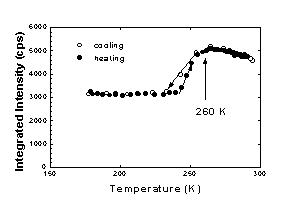
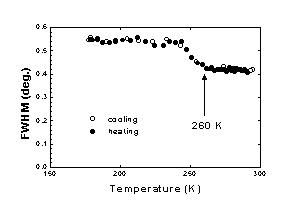
|
FIG.1
Temperature dependencies of (a) integrated intensity and (b) full width
at half maximum (FWHM) of 330b2 Bragg reflection for Au-47.5Cd-0.75Cu
(Q). Open and closed circles are corresponding to the points for cooling
and heating process, respectively (Msskin = 260 K).
A small hysteresis in (a) is observed.
|
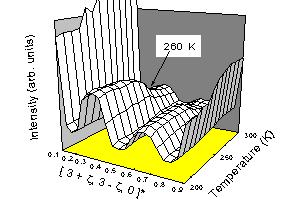 |
FIG.2
Temperature dependence of the diffuse scattering in Au-47.5Cd-0.75Cu
(Q) along K = [3+z, 3-z, 0]* direction (reciprocal lattice units).
The diffuse intensities at z = 1/3 and 2/3 increase below Msskin
(=260 K).
|
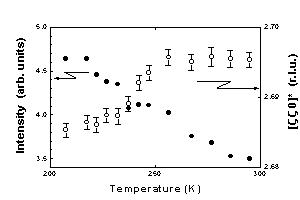
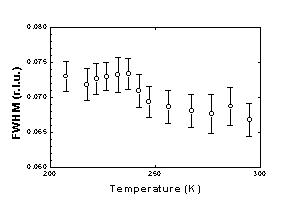
|
FIG.3
Temperature dependencies of
(a) diffuse intensity (closed circles), their position (open circles) and
(b) a peak width (open circles) around q =
3/4[1 0]* position in Au-47.5Cd-0.75Cu (Q). Diffuse intensity
increases monotonously and has no relation with Msskin, though both peak
position and width change at 255 K (<Msskin ).
|
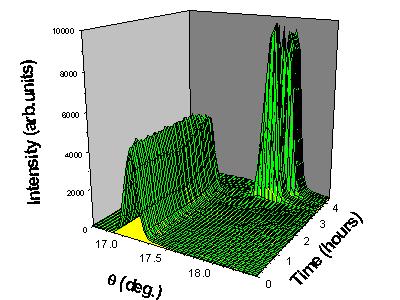 |
Fig. 4
Time dependence of diffraction pattern of 220b2 Bragg reflection
at fixed temperature (261.4 K) above Msskin in Au-47.5Cd-0.75Cu
(Q). A peak position of 220 of b2-phase (parent phase) shifts
continuously and its intensity decreases gradually during the incubation
time. After the incubation time, b2-phase is transformed to
g2'-phase with at least two variants. Bragg peaks for g2'-phase
keep their fixed positions with changing the intensities.
|
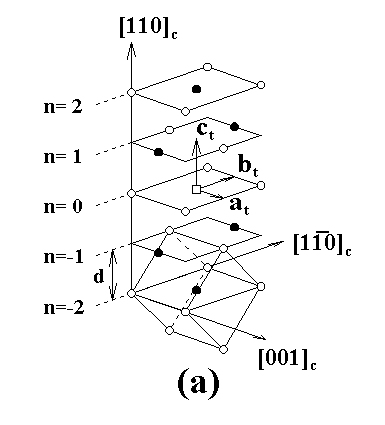
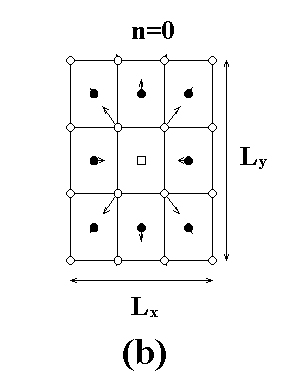
|
Fig. 5
(a) The relation of coordinates between cubic and tetragonal lattices.
A vacancy (an open square) is partially replaced by Cd atom (closed circles),
where Au atoms are shown by open circles. The origin of the tetragonal
coordinate is placed on this vacancy site. (b) Atomic displacements on
(110)c plane including a vacancy site when hxy is magnified by 10. The
first-nearest neighbor atoms against the vacancy become repulsive, the
second-nearest ones become attractive, and so on.
|
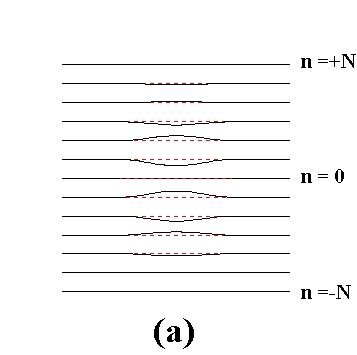
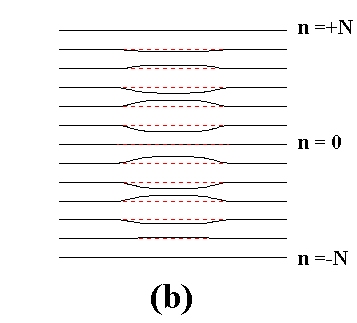
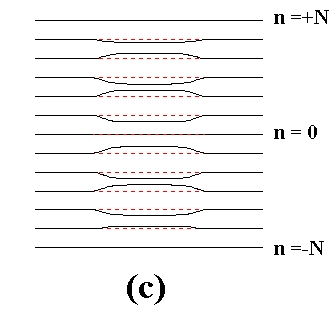
|
Fig. 6
A stacking soliton along [110]c direction given by eq.(1)
accompanying three types of relaxation function; figure (a), (b) and (c)
show each lattice relaxation function described by eqs.(2), (3) and (4),
respectively. Phase shifts disappear on N-th (110)c planes.
|
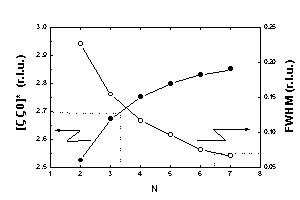 |
FIG.7
Calculated peak position (closed circles) and width (open circles) of 3/4[110]*-diffuse
scattering using a stacking soliton. Small size (N=3) of a stacking soliton
provides the proper peak position, where the experimental result shows
[2.695 2.695 0]*, though large size of a stacking soliton (N=6
or 7) provides the close value of the experimental peak width, 0.068 (reciprocal
lattice units).
|
References
1) L. C. Chang: Acta Crystallogr. 4 (1951) 320.
2) D. S. Lieberman, M. S. Wechsler and T. A. Read: J. Appl. Phys. 26 (1955) 473.
3) R. S. Toth and H. Sato: Acta Metall. 16 (1968) 413.
4) T. Tadaki and K. Shimizu: Trans. JIM 18 (1977) 735.
5) T. Ohba, Y. Emura, S. Miyazaki and K. Otsuka: Mater.Trans. JIM 31 (1990) 12.
6) T. Ohba, Y. Emura and K. Otsuka: Mater.Trans. JIM 33 (1992) 29.
7) N. Nakanishi and C. M. Wayman: Trans. JIM 4 (1963) 179.
8) N. Nakanishi and M. Wayman: Trans. Metall. Soc. AIME 227 (1963) 500.
9) Y. Matsuo, K. Miyata and T. Suzuki: Trans. JIM 29 (1988) 947.
10) Y. Matsuo and K. Miyata: J. Phys. Soc. Jpn. 58 (1989) 3204.
11) H. Terauchi, K. Sakaue and M. Hida: J. Phys. Soc. Jpn. 50 (1981) 3932.
12) Y. Noda, M. Takimoto, T. Nakagawa and Y. Yamada: Metall. Trans. 19A (1988) 265.
13) T. Ohba, S. M. Shapiro, S. Aoki and K. Otsuka: Jpn. J. Appl. Phys. 33 (1994) L1631.
14) H. Abe, K. Ohshima, T. Suzuki, S. Hoshino and K. Kakurai: Phys. Rev. B 49 (1994) 3739.
15) H. Abe and K. Ohshima: J. Phys. Soc. Jpn. 67 (1998) 2952.
16) H. Abe, M. Ishibashi, K. Ohshima, T. Suzuki, M. Wuttig and K. Kakurai: Phys. Rev. B 50 (1994) 9020.
17) H. Abe, R. J. Matsuo, M. Ishibashi, K. Ohshima, M. Imai and K. Kakurai: J. Phys. Soc. Jpn. 66 (1997) 1860.
18) H. Abe, K. Ohshima and T. Suzuki: Mater. Trans. JIM 36 (1995) 1200.
19) T. Kakeshita, K. Kuroiwa, K.Shimizu, T. Ikeda, A. Yamagoshi and M. Date: Mater. Trans. JIM 34 (1993) 415.
20) Y. Noda, S. Nishihara and Y. Yamada: J. Phys. Soc. Jpn. 53 (1984) 4241.
21) N. Hamaya, Y. Yamada, J. D. Axe, D. P. Belanger and S. M. Shapiro: Phys. Rev. B 33 (1986) 7770.
22) M. Imai, K. Kaji and T. Kanaya: Phys. Rev. Lett. 71 (1993) 4162.
23) M. Tadakuma, K. Tajima and G. Masada: J. Phys. Soc. Jpn. 64 (1995) 2074.
24) J. Trenkler, P. C. Chow, P. Wochner, H. Abe, K. E. Bassler, R. Paniago, H. Reichert, D. Scarfe, T. H. Metzger, J.
Peisl, J. Bai and S. C. Moss: Phys. Rev. Lett. 81 (1998) 2276.
25) B. Horovitz, J. L. Murray and J. A. Krumhansl: Phys. Rev. B 18 (1978) 3549.
26) W. Schweika, A. Hoser, M. Martin and A. E. Carlsson: Phys. Rev. B 51 (1995) 15771.
27). W. Schweika: "Disordered Alloys", (Springer, Berlin, 1998)
 Back
to Publications List
Back
to Publications List
ab@nda.ac.jp
Department of Materials Science and Engineering
National Defense Academy
Last Modified: Dec. 21, 2009











